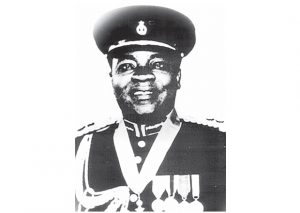A. Casely Hayford, K.A. Gbedemah
On Saturday, May 18, 1957, Prime Minister Kwame Nkrumah, relocated to the Christianborg Castle, otherwise known as Government House.
That became the official residence of the Prime Minister until the Flagstaff House replaced it much later.
The movement was a carefully arranged procedure with staffers of the Cabinet Secretariat proceeding first to receive the Prime Minister.
The colourful movement was characterised by a cocktail party, cabinet ministers and parliamentary secretaries having earlier paid their compliments to the Prime Minister.
The relocation to Government House was the first by a Gold Coaster, and it closed the chapter on its occupancy of the place by British colonial governors for over 55 years.
The last occupant was the first Governor-General Sir Charles Arden-Clarke.
The official statement issued on the occasion reads: “This will be a purely official occasion. Only those who have been officially invited will be admitted.
For the next two weeks, selected members of the public were given the rare opportunity to celebrate the use of the location as the official residence of the Prime Minister, an epoch-making development in the history of the newly independent country.
A garden party was held for some 1,000 persons. That was the first time many were seeing the inside of this colonial structure whose ownership among European powers changed hands over the years.
The first Cabinet meeting to be held in the newly independent country was held on Tuesday, May 21, 1957.
The old Secretariat building in today’s Ministries, provided office accommodation for the Prime Minister until this changed in a fortnight after his movement to Government House.
Earlier, Mr. Ako Adjei, Minister of the Interior, accompanied the Prime Minister to inspect the new offices and living apartments at the Castle. In their company was Mr. WMQ Halme, Chairman of the Industrial Development Corporation.
Prime Minister saw workmen busy putting finishing touches to the new offices ahead of their habitation by the Cabinet Secretariat and Prime Minister’s Office.
Mr. Ako Adjei accompanied by Mr. C.T. Nylander, the Parliamentary Secretary, the Commissioner of Police, Mr. K.N. Collens, the General Officer Commanding the Ghana Military Forces, Maj Gen A.G.V. Paley and the Acting Secretary to the Prime Minister, Mr. John Duncan, undertook standard security checks of the Castle.
It is instructive to note that the Commissioner of Police, Mr. Paley, and the General Officer Commanding the Ghana Military Forces were still British.
Ghana had just attained independence and total takeover by Ghanaians was yet to be achieved.
The official announcement of the relocation was made three weeks later to the people of the new nation by the Prime Minister.
The wording of the announcement underscored the importance attached by the Prime Minister when he told MPs during a parliamentary debate that it was a ‘Psychological Operation’ intended according to him, to “impress upon the people that a new era had dawned.”
The month of May 1957 witnessed a number of developments in the newly independent country, one of them being the first Cabinet reshuffle announced on May 17, 1957.
The MP for Ga Rural, C.T. Nylander, who was earlier Ministerial Secretary at the Ministry of the Interior, Mr. E.K. Bensah, MP for Agona Swedru, previously Ministerial Secretary at the Ministry of Finance and Mr. F.Y. Asare, MP for Buem, formerly Ministerial Secretary at the Ministry of Housing.
Mr. C.T. Nylander took over the Education portfolio as Minister of Education as Mr. Bensah became Minister of Works, and Mr. Asare heading the new Ministry of Labour, Co-Operatives and Social Welfare.
The offices of ministers without portfolio were announced for the first time, persons appointed for the positions being Mr. Kofi Baako, Government Chief Whip. He was attached to the Prime Minister’s Office to assist him in the performance of certain functions.
Others in the line-up were Mr. N.A. Welbeck, former Minister of Works, Mr. Yeboah-Afari, Minister of Agriculture, Mr. J.B. Erzuah, Education Minister and Mr. A. Casely-Hayford, previously in charge of Communications.
The new line-up had Mr. K.A. Gbedemah manning Finance; Kojo Botsio, Commerce and Industry; Ako Adjei, Interior and Justice, and C.T. Nylander, Education.
Prime Minister Kwame Nkrumah held the Defence and External Affairs portfolios.
…Madjitey Heads Accra Police
The first Ghanaian cop to head the Accra Region was a 36-year-old Erasmus R.T. Madjitey.
At the time of independence, he was the most senior cop, hence his appointment.
Having joined the Gold Coast Police Force in 1944 and serving 12 months, he was promoted to the rank of Sub-Inspector. This rank no longer exists in the Ghana Police, the two ranks in the inspectorate class being Inspector and Chief Inspector.
In 1946, Inspector Madjitey proceeded for a Cadet Officers’ Course at the Lancashire Constabulary in Preston, returning a year later. He was promoted upon his return as Assistant Superintendent of Police.
Having served for five years, he returned to England this time to the Metropolitan Police College, Hendon, for the Senior Police Course.
Mr. Madjitey became a household name in the newly independent country because, after all, he was the first indigenous to hold a position which his compatriots never saw one of them hold.

By A.R. Gomda


